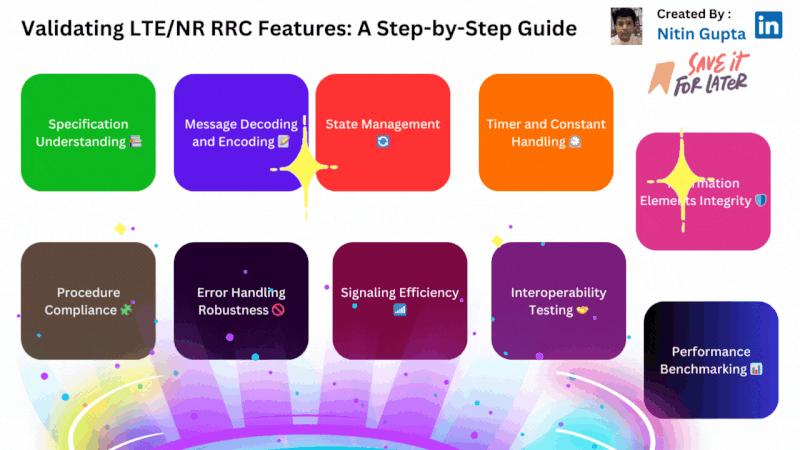-
Specification Understanding
- Example : Before validation, it’s necessary to have an in-depth understanding of the specifications, like knowing that 36.331 defines the procedures and messages of the RRC layer for LTE.
- Validation Step : Ensure the device’s RRC layer correctly implements state transitions, information blocks, and control procedures as per the 3GPP specs.
-
Message Decoding and Encoding
- Example : A device should correctly encode and decode RRC messages like the RRC Connection Setup, which initiates a connection between the UE (User Equipment) and the network.
- Validation Step : Test the UE’s ability to understand and generate compliant messages through simulation or with a test network.
-
State Management
- Example : The device must properly manage states such as IDLE and CONNECTED, transitioning based on user activity or network instructions.
- Validation Step : Validate state transitions through a series of controlled network scenarios to ensure compliance with the standard.
-
Timer and Constant Handling
- Example : Timers like T300, which governs the time waiting for RRC Connection Setup Completion, need to operate within the defined time limits.
- Validation Step : Check if the timers within the UE adhere to the durations specified in the standards.
-
Information Elements Integrity
- Example : Information elements within RRC messages, like the cell access-related information, must be accurately implemented.
- Validation Step : Verify each information element against the standard definitions and permissible values.
-
Procedure Compliance
- Example : Procedures such as the Handover, which involves transferring a UE’s connection from one cell to another, need to be executed as per spec.
- Validation Step : Test handover procedures under various network conditions to ensure seamless execution.
-
Error Handling Robustness
- Example : The device should handle errors like ‘radio link failure’ by trying to re-establish the connection as per the RRC protocol.
- Validation Step : Introduce errors intentionally to observe if the recovery procedures are correctly implemented.
-
Signaling Efficiency
- Example : The RRC Connection Reconfiguration message, which changes the UE’s connection parameters, should be optimized to prevent unnecessary signaling.
- Validation Step : Analyze signaling load during connection reconfiguration to ensure it’s within expected ranges.
-
Interoperability Testing
- Example : Devices should work seamlessly with different network equipment from various vendors.
-
Performance Benchmarking
- Example : The device’s RRC layer performance, such as the setup time for an RRC connection, should meet industry benchmarks.

LinkedIn: ![]()